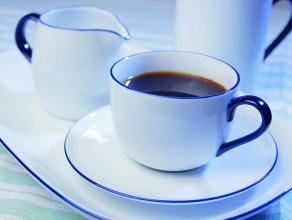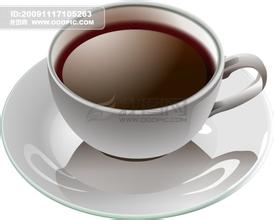Sour and bitter Blue Mountain Coffee Manor in Jamaica the flavor and taste characteristics of Cliff Manor
Most importantly, every afternoon, clouds cover the top of the mountain, which not only shades the coffee trees naturally, but also brings abundant water vapor, which makes the taste and aroma of Blue Mountain coffee outstanding. The same coffee trees taste very different whether they are planted in Hawaii, Kenya, Papua New Guinea or anywhere else with a similar climate. Coffee beans from the lower mountains of Jamaica can only be named "Jamaican Alpine Coffee". As a result, the real Blue Mountain coffee is very small, producing no more than 40, 000 bags (about 2.4 million kilograms) a year, while Brazil, the world's largest coffee exporter, produces 30 million bags of coffee a year.
At the same time, the processing and production process of Blue Mountain Coffee is also very elegant. There are strict and detailed standards for processing, baking, packaging, etc., even to what kind of organic fertilizers are needed during the growth period. It is harvested entirely by hand, and in terms of transportation, Jamaica is the last country to still use traditional wooden barrels to transport coffee. What is even more special is that each barrel is accompanied by a certificate issued and sealed by the Jamaican government to prove its pure pedigree.
After a series of stringent standards set by the Jamaican Coffee Industry Authority, coffee can obtain a guarantee issued by the government, officially known as "Blue Mountain". The real Blue Mountain Coffee perfectly combines the sour, bitter, sweet, mellow and other flavors of coffee, which makes other coffee unmatched. Therefore, Blue Mountain Coffee is generally drunk in the form of black coffee. Most of the Blue Mountain Mountains are more than 1800 meters above sea level, of which the highest peak is 2256 meters above sea level. It is also the highest peak in the Caribbean and is a famous tourist attraction. The unique flavor of Blue Mountain Coffee is related to its unique geographical location and climatic conditions. The Blue Mountain is located in the coffee belt between 25 degrees north latitude and 25 degrees south latitude, with fertile new volcanic soil, fresh air, no pollution and rain all the year round. the temperature difference between day and night is great. The official website of the Jamaican government Blue Mountain Coffee has given a very strict definition: blue Mountain Coffee must be coffee grown in the Blue Mountain area and processed by a government-authorized processing factory. Among them, the definition of the Blue Mountain area is very strict, with detailed provisions for the 16 very specific areas of the Blue Mountain Mountains of Jamaica, and there are only four processing plants designated by the government at present, which are cool and foggy in the Blue Mountain Mountains above 1800 meters. Blue Mountain Coffee has always been praised as the best coffee because of its scarce production and bitter taste. Coffee lovers generally think that Blue Mountain Coffee is the best coffee in the world, and Blue Mountain is definitely one of the most expensive coffee in the world. The classic balance of Blue Mountain Coffee is indeed rare and unattainable. Blue Mountain Coffee is the most superior coffee in the world. Jamaica's weather, geological structure and topography provide an ideal place. The ridge that runs through Jamaica extends to the eastern part of the island, with the Blue Mountains rising to more than 2100 meters. Cool weather, foggy, frequent precipitation, use this rich soil Rain Water to reconcile. Here, a mixed planting method is used to grow coffee trees to accompany banana trees and avocado trees on terraces. Some small estates are also planted. But even the largest landowners in the region are small-scale growers by international standards, many of whom are small landowners whose families have been working for two centuries. The coffee industry in Jamaica faces a series of problems, such as the impact of hurricanes, increased labor costs and difficult mechanization of terraces. Many small estates and farms are difficult to rationalize.
As Japan has always invested in the Jamaican coffee industry, most of the Blue Mountain Coffee is now owned by the Japanese, and they have also obtained the right of priority to buy Blue Mountain Coffee. In 1992, Jamaica sold 688 tons of Blue Mountain coffee to Japan, 75 tons to the United States and 59 tons to Britain. Now, 90% of Blue Mountain coffee is bought by the Japanese. Now that the rest of the world can only get 10% of Blue Mountain, Blue Mountain coffee is always in short supply, regardless of the price. [3]
classification
There are three grades of coffee in the Blue Mountains of Jamaica: blue Mountain Coffee (BlueMountainCoffee), Alpine Coffee (JamaicaHighMountasinSupremeCoffeeBeans) and Jamaican Coffee (JamaicaPrimeCoffeeBeans). Among them, Blue Mountain Coffee and Alpine Coffee are each divided into two grades. In terms of quality, the order from top to bottom is: blue Mountain 1, Blue Mountain 2, Gaoshan 1, Gaoshan 2, Jamaican Coffee. Coffee grown between 457m and 1524 m above sea level is usually called Blue Mountain Coffee. Coffee grown between 274m and 457m above sea level is often called JamaicaPrimeCoffeeBeans, and the price of blue mountain coffee is several times higher than that of alpine coffee. Mainly distributed in JohnCrow,St.John'sPeak,Mossman'sPeak,HighPeak,BlueMountianPeak and other five peaks

Important Notice :
前街咖啡 FrontStreet Coffee has moved to new addredd:
FrontStreet Coffee Address: 315,Donghua East Road,GuangZhou
Tel:020 38364473
- Prev

An introduction to the characteristics of the Blue Mountain Coffee Flavor Manor in Jamaica
Maybe Jamaica Blue Mountain Coffee is the most famous coffee in the world, but in fact, few people know its history and why its price is so high. The first person to introduce coffee to the island of Jamaica in 1789 was a Frenchman who escaped the French Revolution. The first coffee was cultivated to increase local consumption and export in France, and in the first 100 years the local industry
- Next

Malic Acid Nicaraguan Coffee Manor Flavor Taste introduces Joy Manor
Country: Nicaragua planting area: Tianyi Manor planting altitude: 1000-1500 m Bean seed: red Kaduai Red Catuai treatment: honey treatment Honey Cup Test Information: tobacco, Cocoa, Pear, Malic Acid, pleasant, medium Alcohol thickness tabacco, cacao, pear, malic, pleasant, mid body Cup Test score: 86.5 Tianyi Manor is located in Di
Related
- Does Rose Summer choose Blue, Green or Red? Detailed explanation of Rose Summer Coffee plots and Classification in Panamanian Jade Manor
- What is the difference between the origin, producing area, processing plant, cooperative and manor of coffee beans?
- How fine does the espresso powder fit? how to grind the espresso?
- Sca coffee roasting degree color card coffee roasting degree 8 roasting color values what do you mean?
- The practice of lattes: how to make lattes at home
- Introduction to Indonesian Fine Coffee beans-- Java Coffee producing area of Indonesian Arabica Coffee
- How much will the flavor of light and medium roasted rose summer be expressed? What baking level is rose summer suitable for?
- Introduction to the characteristics of washing, sun-drying or wet-planing coffee commonly used in Mantenin, Indonesia
- Price characteristics of Arabica Coffee Bean Starbucks introduction to Manning Coffee Bean Taste producing area Variety Manor
- What is the authentic Yega flavor? What are the flavor characteristics of the really excellent Yejasuffi coffee beans?

